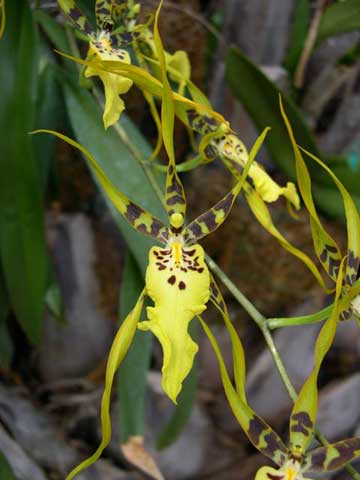 by Preston MacDougall March 28, 2007
Literally. Since I didn't have a pass to the Senate chamber, I crossed First Street and toured the U.S. Botanic Garden Conservatory. It was my maiden voyage through this myriad of flora from all corners of the planet, and quite a few interesting niches as well. My flight was the last one to Nashville, so I had time for a three-hour tour, a three-hour tour. Although there is a fascinating World Deserts exhibit - featuring numerous cactus species with more barbs than the House debate - this is no uncharted desert isle. I grabbed a map at the front desk, and made notes on it as I explored this haven from the politically rough weather across the street. In the West Gallery, it is your sense of smell that does most of the exploring. Seeds of all kinds are grouped in displays that tell the story of spices, such as Asian curry with its blend of turmeric, coriander, cumin, fenugreek, cloves and fennel seeds. I have often wondered how roots and seeds of less-than-tantalizing plants (except for fennel - I love fennel) ended up as key ingredients to delicious entrées. If not for the courage of the fearless crew (in some ancient kitchen) tandoori ovens probably wouldn't be so popular in London. A sign said "Plants are the seeds of our inspiration", and it made me think of a chemist friend who has made a career deriving useful products from pomegranate seeds in New Zealand. The sign was well-placed because the next part of the conservatory was the most "homey" for visiting chemists, thanks to the display of Perkin-Elmer liquid chromatography equipment and polymerase chain reaction thermal cyclers. Tools such as these, which are also common in forensics labs, allow biochemists to extract small amounts of plant DNA, and rapidly multiply the amount so the plant's unique genetic code can be read and stored digitally. If the pharmacologically-active alkaloids in plants aren't the only molecular aspects of plant culture that interest you, then you might enjoy the "Nature's Barcodes" exhibit as much as I did. I learned that biochemists and botanists have teamed-up in a project that will eventually produce a hand-held device that can "read" the genetic fingerprint of any plant from a tropic island nest - no phones, no lights, no motor cars - and instantly identify the exact species. First, however, they must catalogue all of the genetic information for this botanical library. Knowing how tedious such tasks are, they'll be here for a long, long time. Next on the tour you're sure to get a smile - and a blast of warm moist air - as you enter the Orchids exhibit. The kaleidoscopic display of colors and shapes was amazing. There were many varieties similar to the Pink lady's-slippers that I have been lucky to observe on Tennessee's trails. The pallet of colors offered by the Phalaenopsis species impressed me - Golden Treasure is well-named! The biggest surprise for me was Brassia gireoudiana - they were miniature flowering Merlins! The only difference being that the long-limbed, pointy-hatted, floral wizards had long flowing yellow beards instead of white ones. Coincidentally, the professional basketball team in D.C. is the Washington Wizards. I suspect that this plant could be the seed of imagination for a NBA marketing consultant. The Devil's tongue was grotesquely on display in the next exhibit, which was titled Medicinal Plants. The Bleeding-heart tree from the South Pacific took me back to Australia, which I visited two years ago. But upon entering the next room (South Lobby) familiar molecules in the air swept me back almost twenty-five years in a heartbeat. I was blissfully aware of the Gardenia plants before I saw them - a long beautiful row - because his particular plant was the bouquet of choice when Tara McConnell became Tara MacDougall. Next came the barbs previously mentioned, followed by the Oasis, and the Garden Primeval, with ferns, ferns, ferns. There were excellent education exhibits in the East Gallery, which asked the question "What are plants?" A nearby banner cleverly answered it with a catchy phrase that is literally true if you think at the molecular level: "Green machines". I completed a circle when I entered the Garden Court, which is behind the entrance. There where cellos playing and lovers strolling. This being at the opposite end of the Mall from the U.S. Mint, there was bound to be a millionaire about. I didn't recognize any, but with all the anti-war activists in town for the Iraq debate, you just know there was a movie star nearby. In the center of the building is the Jungle. This exhibit can be enjoyed from ground-level, or from above on the Canopy Walk. It's an uphill climb on the art deco-inspired stainless steel stairs, but there are elevators for the less mobile. The huge African tulip trees were very unusual, with fiery-red blooms that were shaped like a pelican's full gullet. When I eventually got to Reagan National airport, my flight was over-booked and somehow I got bumped off. The ginger-haired professor was stranded overnight without his Tara Ann.
On the Web:
Publish A Letter on SitNews Read Letters/Opinions Submit A Letter to the Editor
|
||
